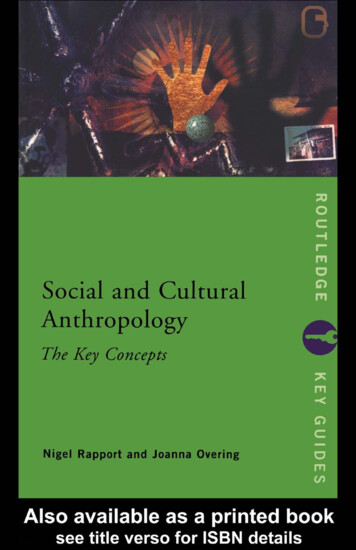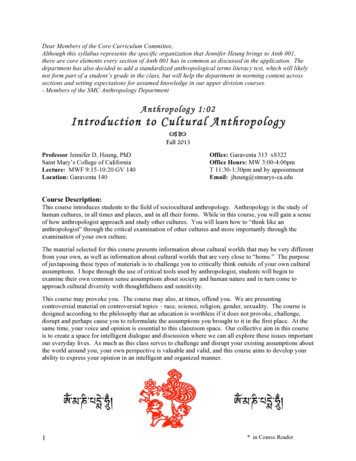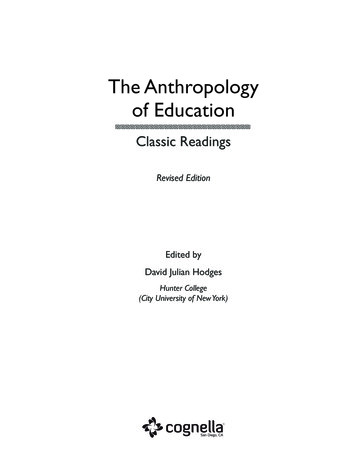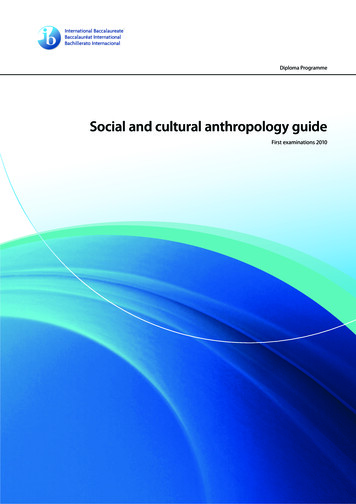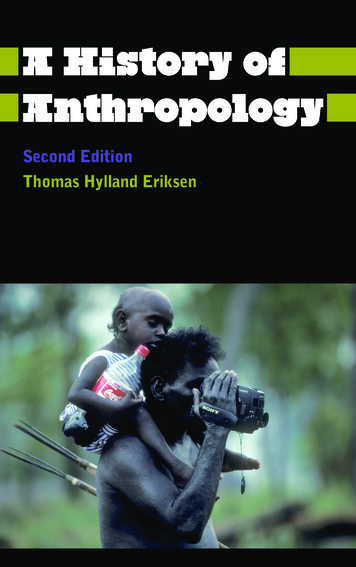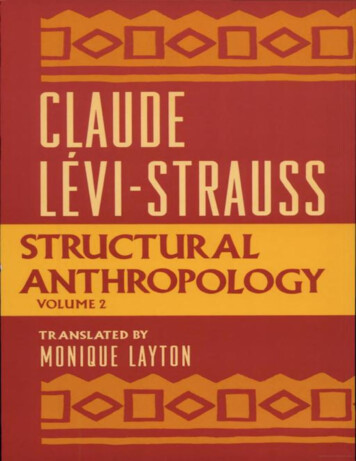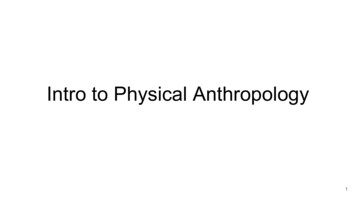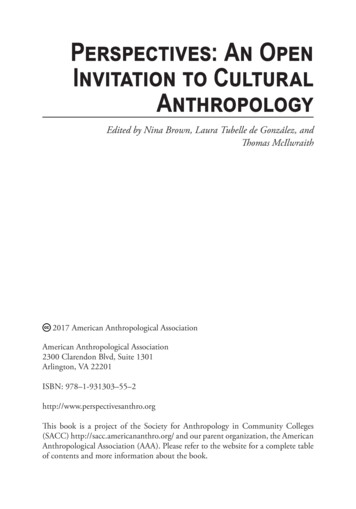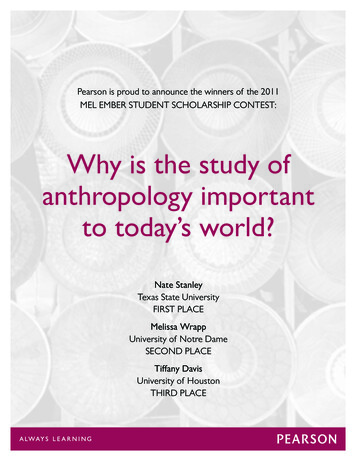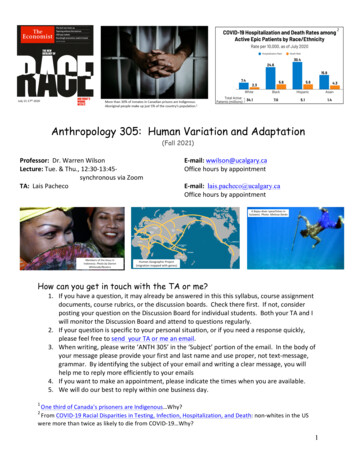
Transcription
Anthropology 305: Human Variation and Adaptation(Fall 2021)Professor: Dr. Warren WilsonLecture: Tue. & Thu., 12:30-13:45synchronous via ZoomTA: Lais PachecoE-mail: wwilson@ucalgary.caOffice hours by appointmentE-mail: lais.pacheco@ucalgary.caOffice hours by appointmentHow can you get in touch with the TA or me?1. If you have a question, it may already be answered in this this syllabus, course assignmentdocuments, course rubrics, or the discussion boards. Check there first. If not, considerposting your question on the Discussion Board for individual students. Both your TA and Iwill monitor the Discussion Board and attend to questions regularly.2. If your question is specific to your personal situation, or if you need a response quickly,please feel free to send your TA or me an email.3. When writing, please write ‘ANTH 305’ in the ‘Subject’ portion of the email. In the body ofyour message please provide your first and last name and use proper, not text-message,grammar. By identifying the subject of your email and writing a clear message, you willhelp me to reply more efficiently to your emails4. If you want to make an appointment, please indicate the times when you are available.5. We will do our best to reply within one business day.1One third of Canada's prisoners are Indigenous Why?From COVID-19 Racial Disparities in Testing, Infection, Hospitalization, and Death: non-whites in the USwere more than twice as likely to die from COVID-19 Why?21
Course Calendar Statement: Some of the major problems involved in interpreting modernand recent human diversity. Emphasis on the interaction between human cultural and biologicalsystems and on cultural influences upon human biological diversity.How do humans vary? Does it matter?In Natural History, Roman scientific writer Pliny the Elder (AD 23/24 – 79) remarked that,although human countenance is made up of only “ten parts or a little more,” people were sofashioned that “among the many thousands no two exist who cannot be distinguished.” Pliny’swords still resonate with us in 2021 as we seek to make sense the differences between people inthe face of COVID19 and protestors crying out for social justice. How are we to explain this richmultiplicity of human physical forms? Anthropology can assist us in our efforts to answer thisquestion. Anthropologists investigate the nature and causes of human variation as well as thosecharacteristics that are common to all of humanity. In this course we will consider humanvariation from the perspective of the anthropological sub-discipline biological anthropology whichfocuses specifically on human biological variation. Biological anthropologists recognize thatcontemporary human variation can be explained by the interaction between biology and culture.Hence, our work is informed by evolutionary theory, biology, human evolution, the study of nonhuman primates, and the cultural context in which we find the variation (Figure 1).Figure 1: Variables which inform our understanding of contemporary human variation4(1 Cultural anthropology, 2 Paleoanthropology, 3 Primatology,Human Population Biology 2-3 are subdisciplines of biological anthropology!)2
Utilizing the perspective of biological anthropology, the goal of this course is to introduceyou to the scientific study of human variation (Figure 2). We will begin with a consideration of theorigins and impacts of the concept of race and follow this with an overview of the scientificmethod and the anthropological approach to the study of human variation. We will then coverthe biological bases of human variation in discussions of genes in human populations, theheritability of traits, and population genetics. In the latter part of the course we will look athuman variation as the outcome of adaptation to a variety of environmental challenges. Thiscourse should help you to understand the biology underlying the variation of human physical andpsychic forms and to sort fact from fiction in the contentious and clouded debates over humanvariation.So, does this matter? Does this material have any bearing upon your life? I wouldn’t teachthis if I didn’t strongly believe that it does. Do not, however, take my word for it. Ask thesequestions every time you engage with this course. I’ll be curious to hear your answer when thecourse wraps up!Figure 2: Course Map3
Learning ObjectivesUpon completion of this course, you should be able to:1. describe the goals and methods of the social and natural sciences and the humanities,2. describe the history and current scientific understanding of the concept of race,3. explain how a misunderstanding of human variation played a role in eugenics & theHolocaust,4. describe sources of human phenotypic variation, in general,5. describe the history and current scientific understanding of intelligence testing,6. describe anthropological perspectives on gender,7. describe the three levels of human adaptation to stress,8. describe how humans adapt to solar radiation, cold & heat stress, hypoxia, and infectiousdisease,9. link the knowledge obtained in this course to your everyday life and events in the news.Teaching Philosophy1In this course I do not seek to provide you with an intellectually safe space; rather Iendeavor to challenge you with new ideas with which you will have to engage to reach your own,informed conclusions. Students in my classes are encouraged to speak, write, listen, challenge,and learn, without fear of censorship. The free exchange of ideas is a fundamental part ofdemocratic society. That said, civility and mutual respect are vital to all of us, and freedom ofexpression does not mean the freedom to harass or threaten others. I consequently expect you tobe engaged in evidence-based, rigorous debate, discussion, and even disagreement with oneanother and me. At times, this may challenge you and even cause discomfort. Indeed, as we willconsider some of the most horrific acts of inhumanity that have arisen due to human variation,such as sexual and physical violence and assault, racism, sexism, discrimination based on sexualorientation, genocide, war, the physical and psychological abuse of children, suicide, and drug andalcohol abuse, this course should be unsettling. Our consideration of these domains is notgratuitous: a failure to understand the basis and potential for such acts puts us at risk of repeatingthem.1For more on my teaching philosophy, please see: Delbanco, A (2012) What is college for? Continuing HigherEducation Review 76:11-19. https://files.eric.ed.gov/fulltext/EJ1000647.pdf4
Course Conventions1. Modality: This course will take place online via Desire2Learn (D2L) and Zoom. To best succeedin the course, you are encouraged to participate in the asynchronous learning tasks using the D2Llearning environment and synchronous Zoom sessions. When unable to participate live due to thetime difference or unforeseen circumstances, inform the instructor in advance and propose andimplement propose an alternative participation activity (e.g., watch the recordings, submit a briefreflection, and actively contribute to the follow-up online discussion). All but two classes (Oct. 28& Nov. 4) will be held synchronously (see ‘Schedule’ below). The classes on Oct. 28 and Nov. 4 willbe posted on D2L and held asynchronously.Guide to Zoom:Zoom is a video conferencing program that will allow us to meet at specific times for a “live” videoconference, so that we can have the opportunity to meet each other virtually and discuss relevantcourse topics as a learning community.To help ensure Zoom sessions are private, do not share the Zoom link or password with others, oron any social media platforms. Zoom links and passwords are only intended for studentsregistered in the course. Zoom recordings and materials presented in Zoom, including any teachingmaterials, must not be shared, distributed or published without the instructor’s permission.The use of video conferencing programs relies on participants to act ethically, honestly and withintegrity; and in accordance with the principles of fairness, good faith, and respect. When enteringZoom or other video conferencing sessions (such as MS Teams), you play a role in helping createan effective, safe and respectful learning environment. Please be mindful of how your behaviour inthese sessions may affect others. Participants are required to use names officially associated withtheir UCID (legal or preferred names listed in the Student Centre) when engaging in theseactivities. Instructors/moderators can remove those whose names do not appear on class rosters.Non-compliance may be investigated under relevant University of Calgary conduct policies. Ifparticipants have difficulties complying with this requirement, they should email the instructor ofthe class explaining why, so the instructor may consider whether to grant an exception, and onwhat terms. For more information on how to get the most out of your zoom sessions om.If you are unable to attend a Zoom session, please contact your instructor to arrange analternative activity for the missed session (e.g., to review a recorded session). Please be prepared,as best as you are able, to join class in a quiet space that will allow you to be fully present andengaged in Zoom sessions. Students will be advised by their instructor when they are expected toturn on their webcam (for group work, presentations, etc.).The instructor may record online Zoom class sessions for the purposes of supporting studentlearning in this class – such as making the recording available for review of the session or forstudents who miss a session. Students will be advised before the instructor initiates a recording ofa Zoom session. These recordings will be used to support student learning only and will not beshared or used for any other purpose.5
2. Prerequisites: One of Anthropology 201, Archaeology 203, or Biology 205 or 241. You musthave a basic understanding of molecular genetics, the inheritance of simple (Mendelian) traits,evolutionary theory, and human evolution prior to taking this course. If you are concerned aboutthis, please contact me during the first week of classes.3. Breakout rooms: In an effort to engage you in the learning process I will often use “think-pairshare” or “think-write-pair-share” to have you explore topics and answer questions with two tothree of your classmates selected randomly by the computer. This generally will mean that I willask you to think about a question, then put you in a breakout room with two to three people youmay or may not know to discuss the question for 5-10 minutes. After bringing you “back” to theclassroom, I will ask you to share what your group concluded. This behooves you to come to classprepared. For some it is uncomfortable to be placed in rooms with strangers. Showing up with nounderstanding of the material will further compromise your experience and what you take awayfrom this class. Note that if you feel awkward in breakout rooms, you are not alone. I do this notto torment you but because this method has been found to improve student engagement,differentiate instruction and give you more of a voice in a large class where you otherwise mighthave none.4. Learning Resources: : reading assignments will be found both online in the “CourseDocuments” section of the class Desire2Learn website. In addition to the required readings,recommended readings are often provided to enhance your knowledge of the subject in question.Keep in mind that you are not finished with the reading, podcast, or video assignment until youthoroughly understand it. This will sometimes require you to read, listen to, or watch the assignedmaterial more than once. An effective way of ensuring comprehension is to read, listen to, orwatch the assignment then go back through it and summarize its main points and supportingevidence in your notebook.5. Content Warning: As I note above in my “Teaching Philosophy” section, some of the materialsand topics in this class will include explicit content (violence; sexuality; profanity; blasphemous,objectionable or illegal conduct). If you feel any materials may cause you distress or severediscomfort, you are encouraged to speak with me or the teaching assistant and/or take measuresto ensure that you feel braver in the classroom. You will not be exempt from any assigned work,but we will gladly work with you to accommodate your concerns.6. Evaluation: You will be evaluated based on your performance on two rounds of structureddiscussion boards which you will complete in groups, a midterm exam, a comprehensive finalexam, and reflective journals. The assignments for the structured discussion boards and reflectivejournal can be found in D2L in Content Discussion Board Assignment & Content ReflectiveJournal Assignment. Deadlines for assignments can be found below in the course Schedule.6
Guide to Exams: The one Mid-term Exam and one comprehensive Final Exam will be found in D2L in theAssessments Quizzes on the day of the exam. At least six days prior to each exam I will hand out a list of key terms and concepts that will becovered on the exams. In preparing for each exam, you should not define each key term inisolation; rather, define and understand it in relation to the other key terms within the contextof the course. For the midterm you will have 75 minutes to complete 75 questions, plus 15 minutes extra incase of tech difficulties, for an overall total of 90 minutes to complete the exam. The registrarwill set the time for the registrar-scheduled, final exam. The majority of questions will be multiple choice format with a small number of short-answerquestions. Multiple choice questions will have either 4 or 5 possible answers. One question will appear at a time and you cannot scroll forward or backward through thequestions, you must answer each question when it appears and move on to the next. The mid-term exam will be accessible to you from 12:01 am to 11:59 pm on the date of theexam. Once you start your test it will stay open until you answer all of the questions or for 90minutes, whichever comes first. Keep track of the time, as the mid-term exam will close after 90 minutes, whether you haveanswered all of the questions or not, just as it would if you were writing it in class in person. Do not logout until after you have answered all of the questions as you have one attempt only,you will not be able to get back in. You can take a break and walk away from your computer ifyou like but do not logout. You may consult your personal notes and readings while completing the tests, but not theinternet. In other words, you are not permitted to google terms or questions. Also prohibited:communicating with other people in any way (remote or in person) during the test, sharingtest information during or after you have taken the test, capturing (screen shot or photo)images of the questions, or sharing images of questions. As well, for 24-hour window for bothyour mid-term and final exam, you are not allowed to use any Discord sites set up for and bystudents in this class. A failure to abide by these guidelines would constitute a breach ofacademic integrity with detrimental repercussions. Why is the exam available to you for 24 hours? This 24-hour window is intended to allow youto find the best time (fewest distractions etc.) and place (good computer and Wi-Fi connection)for you to take the test. It is up to you to ensure that you have a good space to work in, withaccess to a decent device and a secure internet connection, to take the test. We cannotaccommodate problems that derive from you not having prepared for this in advance. This iswhy you have a 24-hour time frame to take the test. We do not answer questions during exams in regular in person classes and likewise will not beanswering questions during tests or the exam in this class. This means that everyone hasaccess to the same information and we do not provide additional information or clarification tosome students and not others. Questions or concerns will be handled via email in the daysfollowing the tests. Please do not send email inquiries about the test on the test day. Wait until at least the nextday. The University is working hard to understand and accommodate the stress that students arefacing during this pandemic and the necessary remote learning/testing environment. Pleaserespect that this is being done to support you and choose to behave with integrity.7
Your final grade will be calculated as follows:ItemMid-Term ExamFinal ExamStructured, Online Discussion BoardReflective JournalWeight26%36%16%22%A passing grade is not required on any particular component for the student to pass the course asa whole; that is, a student may fail, for example, Exam #1 or any other component and, assumingtheir overall average percentage earned for the course is above 49.8, they will pass the course.GRADING SCHEME:Each item of course work will be weighted as above and a final mark out of 100 calculated. Thiswill then be converted to a letter grade as follows:A B C D 94.9–10079.9–84.8 %66.9–70.8 %54.9 %– 58.8%ABCD89.9–94.8%74.9–79.8 %62.9–66.8 %49.9–54.8 %ABCF84.9–89.8 %70.9–74.8 %58.9–62.8 %49.8 and belowPer the University of Calgary Calendar, an “A” is earned for “superior performance, showingcomprehensive understanding of subject matter”. Superior performance is, by definition, rare;that is, superior is defined as “highest in quality”. More common is the grade of “B” which isearned for “clearly above average performance with knowledge of subject matter generallycomplete”. More common still is the grade of “C” which is earned for a “basic understanding ofthe subject matter”. If you require clarification on letter grade assignments, please contact mewithin the first two weeks of the semester. Keep in mind that, you have paid for the opportunityto learn, not a grade. As such, my teaching assistant and I do our utmost to ensure that you havethe best possible learning opportunity in this course.Guidelines for the Reappraisal of Graded Term Work and the Reappraisal of AcademicAssessments (Final Grades) can be found here and here.What to do if you miss a required component of the course (e.g., miss an assignment deadline oraniss an exams): If you miss a required component of this course, you may be asked to providesupporting documentation for an exemption/special request. This may include, but is not limitedto, a prolonged absence from a course where participation is required, a missed courseassessment, a deferred examination, or an appeal. Students are encouraged to submitdocumentation that will support their situation. Supporting documentation may be dependent onthe reason noted in their personal statement/explanation provided to explain their situation. Thiscould be medical certificate/documentation, references, police reports, invitation letter, or astatutory declaration, etc. The decision to provide supporting documentation that best suits thesituation is at the discretion of the student. You are not required to provide specific supportingdocumentation, such as a medical note. Students can make a Statutory Declaration as their8
supporting documentation (available at ucalgary.ca/registrar). This requires students to make adeclaration in the presence of a Commissioner for Oaths. It demonstrates the importance ofhonest and accurate information provided and is a legally binding declaration. Several registeredCommissioners for Oaths are available to students at no charge, on campus, please seeucalgary.ca/registrar. Falsification of any supporting documentation will be taken very seriouslyand may result in disciplinary action through the Academic Discipline regulations or the StudentNon-Academic Misconduct policy. Note that, deferral of the registrar scheduled final examrequires Registrar approval. For more detail, please see the Guidelines for the Deferral of TermWork here.7. Office Hours: I enjoy conversations with students. Whether you would like to discuss ingreater detail something that was touched on in class or the assigned material or are havingdifficulty with some aspect of the course, both my TA and I are happy to meet as necessary.8. Academic misconduct: “Academic Misconduct” includes such things as cheating, falsification,plagiarism, unauthorized assistance, and failure to comply with exam regulations or an Instructor’sexpectations regarding conduct required of Students completing academic assessments. Studentswho participate in, or encourage the commission of, Academic Misconduct will be subject todisciplinary action which could include Probation, Suspension, or Expulsion from the University.For information on academic misconduct and its consequences, please see the University ofCalgary Calendar at htmlFurther support on academic integrity is available at: s/learning/academic-integrity9. Learning Technologies and Requirements: There is a D2L site for this course which containsrequired readings and other relevant class resources and materials. In this online course, studentsare required to have reliable access to the following technology: A computer with a supported operating system, as well as the latest security, andmalware updates; A current and updated web browser; Webcam (built-in or external); Microphone and speaker (built-in or external), or headset with microphone; Current antivirus and/or firewall software enabled; Broadband internet connection.Most current laptops will have a built-in webcam, speaker and microphone.I appreciate that not all students can afford this without some financial assistance. A few optionsfor financial assistance can be found here.10. Intellectual Property: Course materials created by professor(s) (including course outlines,presentations and posted notes, labs, case studies, assignments and exams) remain theintellectual property of the professor(s). These materials may NOT be reproduced, redistributed orcopied without the explicit consent of the professor. The posting of course materials to third partywebsites such as note-sharing sites without permission is prohibited. Sharing of extracts of thesecourse materials with other students enrolled in the course at the same time may be allowedunder fair dealing.9
11. Copyright Legislation: All students are required to read the University of Calgary policy onAcceptable Use of Material Protected by Copyright copyright-policy) and requirements of thecopyright act ex.html) to ensure they are awareof the consequences of unauthorized sharing of course materials (including instructor notes,electronic versions of textbooks, etc.). Students who use material protected by copyright inviolation of this policy may be disciplined under the Non-Academic Misconduct Policy.12. Academic Accommodations: Students seeking an accommodation based on disability ormedical concerns should contact Student Accessibility Services; SAS will process the request andissue letters of accommodation to instructors. For additional information on support services andaccommodations for students with disabilities, visit access. Students who require an accommodation in relation to their coursework based ona protected ground other than disability should communicate this need in writing to theirInstructor or the Department Head. The full policy on Student Accommodations is available lities-procedure.13. Support and Resources: Please visit the Registrar’s website course-outlines for additional importantinformation on the following: Emergency Evacuation/Assembly Points Wellness and Mental Health Resources Student Success Centre Student Ombuds Office Student Union (SU) Information Safewalk14. Freedom of Information and Protection of Privacy: Student information will be collected inaccordance with typical (or usual) classroom practice. Students’ assignments will be accessibleonly by the authorized course faculty. Private information related to the individual student istreated with the utmost regard by the faculty at the University of Calgary.15. Discord Channels: The Department of Anthropology & Archaeology has maderecommendations regarding Discord channels created by students for our courses. In this course Iwill implement them as follows:1) A Discord channel must have the TA as an administrator for the channel allowing the TAto monitor the channel.2) The channel must be limited to the main one and only one offshoot channel. Otherwise,it becomes too difficult to monitor.3) Do not go on Discord during the 24-hour test period and do not discuss the test in anyway. The TA also has hours in the 24 hour time frame of the test to monitor discord.4) All members of the class must be invited to the Discord channel.I also remind you that while Discord is not a U of C supported platform, U of C Academic Integritystandards still apply.10
Treaty Acknowledgement: The University of Calgary, located in the heart of Southern Alberta, bothacknowledges and pays tribute to the traditional territories of the peoples of Treaty 7, which includesthe Blackfoot Confederacy (comprised of the Siksika, the Piikuni, and the Kainai) as well as theTsuut’ina and the Stoney Nakoda (including Chiniki, Bearspaw, and Wesley First Nations). TheUniversity of Calgary is situated on land adjacent to where the Bow River meets the Elbow River. TheUniversity recognizes the traditional Blackfoot name of this place, Moh’kíns’tsis, now known as the Cityof Calgary. The University recognizes that the City of Calgary is also home to Region III of the MétisNation of Alberta. By virtue of the 1877 signing of Treaty 7, the university recognizes that we are alltreaty people. The City of Calgary is home to a culturally diverse community. Together, we share thisland, strive to live together, learn together, walk together, and grow together “in a good way.” ii’ taa’poh’ to’ pSchedule1ItemDateTopicAssigned Readings, Films, & Podcasts2Class 17-SepHow might we think about humanvariation? V(P) V(G) V(E)Class 29-Sepcourse syllabus, Understanding Science; Kristof; ImplicitAssociation Test-RaceCulotta; Canadian Race Relations. Optional: Lipstadt;GladstoneClass 314-SepClass 416-SepClass 5Class 621-Sep23-SepClass 728-SepClass 85-OctWho am I?, Anthropology, Race, IATWhat is race?, Critical thinking sidebar:peer review, A cautionary tale, Raceconcept-informal originsRace concept-informal origins (cont.) &evolutionary theory, Critical thinkingsidebar: research, natural experimentsRace concept-scientific origins, Whyrejection of race concept?Why rejection of race concept? (cont.)Why rejection of the race concept?(cont.), What is race?National Day for Truth andReconciliation (no class)Implications of race concept: genocide,social DarwinismClass 97-OctSources of genetic variationno class30-SepAssignment11-OctClass 1012-OctClass 1114-OctExamClass 1219-Oct21-OctClass 13AssignmentClass 1426-Oct25-Oct27-OctClass 1528-OctClass 2023-NovAkpan or Wiesel. Optional: ; Critchley; Statistics Canada;Weintraub.Appiah. Optional: Bauer & Blumenthal; Milgram; SSRC;AmodioMarksRace the Power of Illusion. Optional: Barbujani et al.U. Utah – SNPs. Optional: Disotell; Whitman.Optional: Honouring the Truth, Reconciling for the FutureReading on eugenics/genocide TBD. Optional: Claeys,O'Connell & Ruse, WhitmanLewis (Beyond Mendel’s Laws); U. Utah – GenomicImprinting. Optional: Weiss & Tackney (review of basicgenetics)Discussion Board Topic 1: Group response A dueU. Utah – Epigenetics & Inheritance; Ghost in YourSources of genetic variation (cont.),Genes. Optional: Mendelian Inheritance.; Informedgenes, patterns of inheritanceconsent ; Epigenetics 101; Epigenetics & 9/11Jones (Calliban’s Revenge), Singer (2018). Optional:Patterns of inheritance (cont.)RadiolabMid-Term ExamQuantitative geneticsGroopman; Lewis (Multifactorial Traits)IQ, Intelligence, & Heritability. Sidebar:CRISPRLewontin (Mental Traits).Discussion Board Topic 1: Group response B dueIQ, Intelligence, & HeritabilityResnick. Optional: Hidden BrainImplicit Association Test-Gender; How is sex determined?Henig. Optional: Intersex Society of North America;Human variation in complex traits - Sex Graves; Fausto-Sterling (2000), Padawar; Minto.Adaptation to hypoxic stress: highContinued on the next page!altitude & under the sea11
ItemDateClass 162-NovClass 174-NovBreak!Class 18AssignmentAssigned Readings, Films, & Podcasts2TopicHuman variation in complex traits –Gender (anthropological view)Human population biology:homeostasis, adaptation, & stressSapolsky. Optional: Belluck, BergnerStinson et al.9 & 11-Nov.Reading Week- no classes16-Nov Adaptation to climatic stress: UVRJablonski17-NovDiscussion Board Topic 2: Group response A dueClass 1918-NovClass 20Class 2123-Nov25-NovAdaptation to climatic stress: hot &coldAdaptation to hypoxic stress: highaltitude & under the seaAdaptation to disease stressClass 2230-NovAdaptation to disease stress (cont.)Beall. Optional: Baranova et al.Sattenspiel & Slonim (pp. 387-418). Optional: Orent,Sattenspiel & Slonim (pp. 418-440). Optional: Jacobs &RichtelClass 232-DecAdaptation to disease stress (cont.)Sattenspiel & Slonim (pp. 440-450).Class 247-DecStress & human variationStress: Portait of a KillerClass 25AssignmentFinal Exam19-Dec10-DecTBDSteegmanCouse wrap upThis American Life (“Words”)Discussion Board Topic 2: Group response B dueComprehensive, registrar scheduled, final examThe schedule of topics may change, but the exam dates and
6 2. Prerequisites: One of Anthropology 201, Archaeology 203, or Biology 205 or 241. You must have a basic understanding of molecular genetics, the inheritance of simple (Mendelian) traits, evolutionary theory, and human evolution prior to taking this course. If you are concerned about

